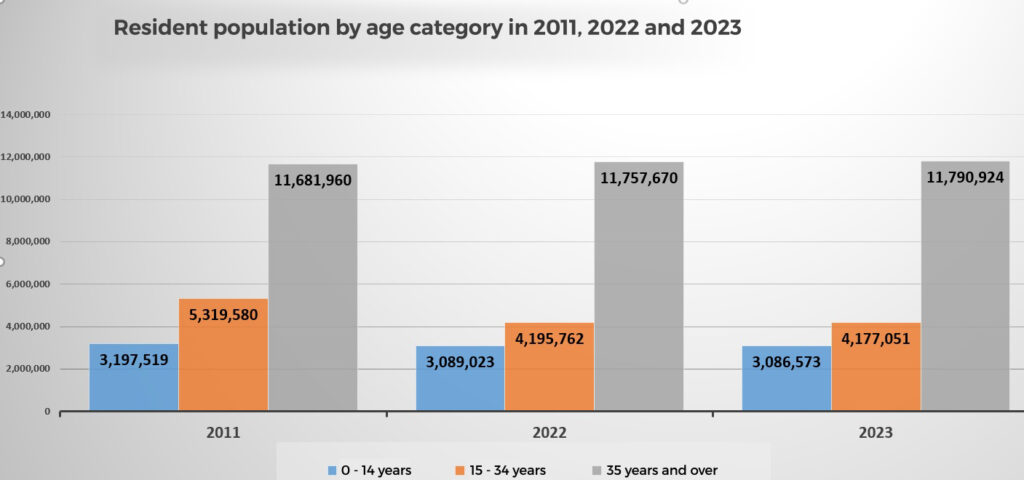Romania’s resident population decreased between the last censuses – from the one in 2011 to the one in 2022 – by over a million people, but what is worse is that the drop is registered almost entirely among youths, that is, among those between the ages of 15 and 34.
In terms of the other two main age categories, the dynamics were insignificant – between 2011 and 2022, the population aged between 0 and 14 decreased by 108,500 people, while the population aged over 35 increased by nearly 76,000.
The trends maintained in 2023 – the number of youths is dropping at a faster pace than that of children, while the top part of the pyramid (of those aged over 35) is growing faster still – and demographic projections show the dynamics of the three age categories will continue along the same lines until the critical moment when the pyramid will become reversed.
Despite the phenomenon we have been witnessing for several decades, governing bodies have never intervened with policies backed by coherent and effective programs to stop the demographic bomb’s slow motion explosion we are already witnessing.
Its impact is predictable and has been described for many years by demographers and economic analysts: fewer and fewer generations entered the labor market with record rates of school dropout being registered.
These phenomena translate into declining pensions and health contributions, with which the pensions and health expenses of a record population of pensioners will have to be supported in Romania.
The situation of youths, according to an analysis by the Economic and Social Council – ESC
The share of youths in the general resident population has subsequently dropped from 27.37% in 2011 to 23.61% in 2022, mainly due to the decline in birth rate in the 90s and early 2000s, but also due to migration. In the decade between the two censuses, over 100,000 young people settled abroad definitely.
High chance of higher education, but huge percentage of early school dropouts
According to a study by the Economic and Social Council (ESC), educational opportunities for today’s young people are clearly superior to those of previous generations.
Thus:
- The share of young adults in the 20-24 age group who graduated from high-school or vocational schools is nearly 10% higher than that of the working age group.
- Youths aged between 25 and 34 are twice as likely to have completed higher education compared to the active generation. In 2019, the share of people aged between 30 and 34 who had completed higher education was 25.8%.
Dropout, unemployment and poverty rates far exceeding those of previous generations and setting records in the EU
- The cohort that took the National Assessment exam last year lost 10.4% of students in primary and secondary school, with a dropout rate of 7.4%. These young people will have little chance of earning incomes much higher than the minimum wage in the economy.
- The unemployment rate of youths up to 25 years of age exceeded 22% again in January this year, after having dropped to 21.3% last year. The unemployment rate of the working age population was 5.7%.
- The rate of young people who in 2022 were not in employment, education or training, the so-called NEETs, was 19.8% in Romania, the highest rate in the EU.
- Although the poverty rate for children and youths under 18 has decreased significantly over the last years, this category remains the group most affected by poverty, well above the percentage of adults. In 2022, Romania had the highest percentage (37.9%) of youths at risk of poverty and social exclusion at EU level.
Ostensible strategies – unrealistic and unfunded
These negative performances were never addressed coherently and the ESC analysis shows that all strategies in the field were unrealistic and contrived.
Starting with 2014, two Implementation Plans for the “Youth Guarantee” program (IPYG) were developed in Romania, documents which held abnormal targets, as shown by the ESC, in one of many available examples:
“In total, over 2 million youths were considered with specific measures by the IPYG 2017-2020, given that the total number of young people aged between 15 and 24 residing in Romania on January 1, 2017, was 2,122,771, according to NIS data.
On January 1, 2020, when the review of the OPHC was carried out, the total number of resident youths aged between 15 and 24, was 2,028,782, while the number of young people aged between 15 and 29 was 3,083,637.
The fact that the intended target is unrealistic can also be noted from the comparison of the target set in Romania, of over 2 million youths, with the achievements at EU level in the 2014-2019 interval: 2.4 million youths supported directly and 3.5 million supported directly and indirectly.”
Insufficient funds
Money allocated to combating the situation of youths was insufficient from the start and often reduced as some of the programs progressed. Such was the case of the funds dedicated to the return to education of young NEETs in 2020, shows ESC.
European funds, inefficiently spent
- The projects completed by 2022, with funds allocated for the financial interval 2014 – 2020, support or have supported with professional training and other employment measures only 23,829 youths, representing less than 1% of the 2.4 million young people supported at European level according to the EC, stated the ESC study, referring to data available at the end of 2022.
- Out of the total RON 2.672 million approved financing from EU funds by October 31, 2022, for OPHC chapters intended for youths, RON 755 million were paid to beneficiaries, which represents an absorption rate of 28.25% of the contracted total.
***











